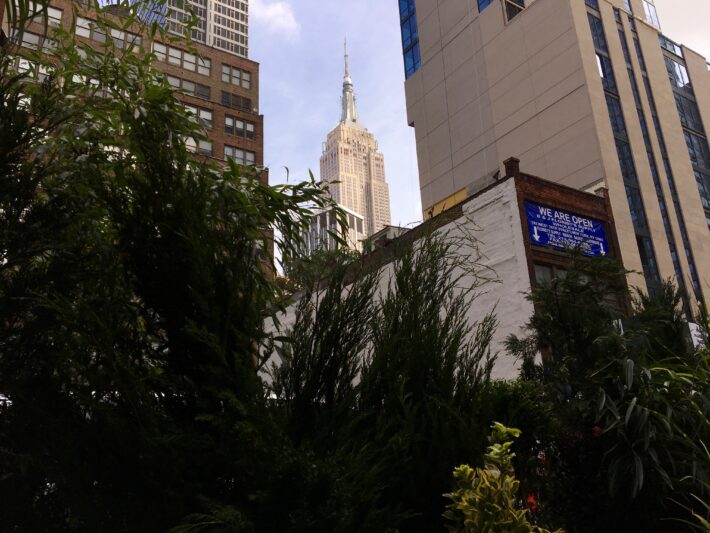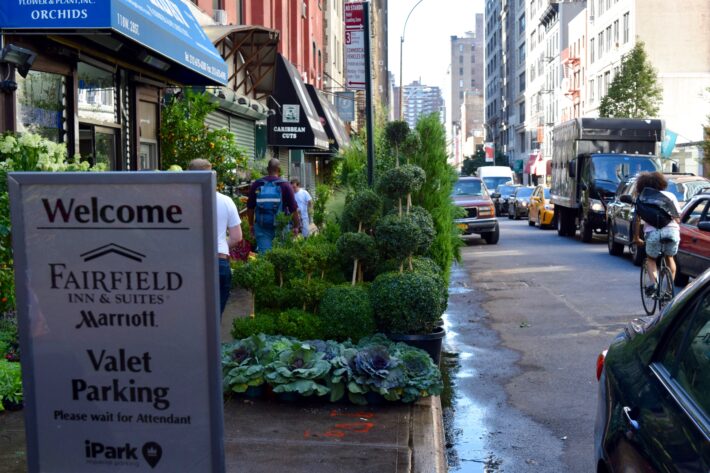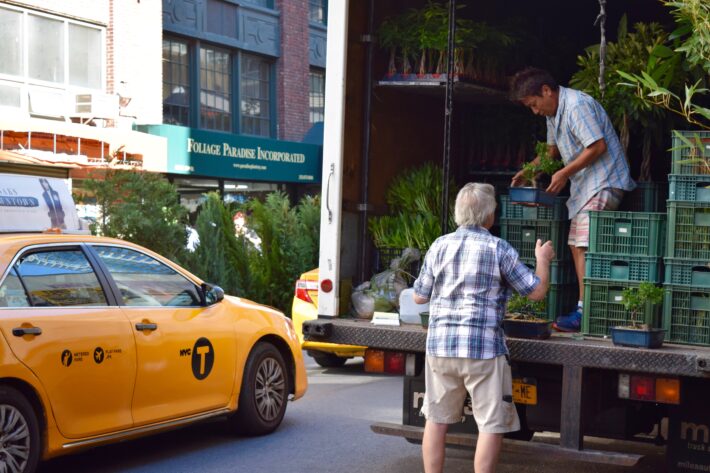
Ched Markovic has been selling flowers on West 28th Street for 39 years. But recently he reached his breaking point with the congestion and traffic affecting the block between Seventh Avenue and Broadway, known as the Flower District.
“I can’t park, our customers cannot park, and I almost got killed three days ago,” said Markovic.
Markovic described how during a recent rainstorm, a wooden access ladder plummeted from a hotel under construction across the street, missing him by mere feet. The incident is indicative of the many pressures on Flower District wholesalers like Markovic, the owner of Noble Plants.
“People can’t come,” he said, because of construction, “and the guys who deliver to me are always cursing – ‘I have to bring it from there because I cannot park here.’”
The four large hotels on the block, and two more under construction near the corner of Sixth Avenue, are symptoms of change in west midtown that threaten this historic block, which has existed as a nexus of flower sellers since the early 20th century. Wholesalers’ pick-up and delivery vans are waylaid or ticketed because of the traffic choking 28th Street. Encroaching development is also squeezing the remaining flower stores in space and rent prices.
Gary Page, the founder and president of the now-defunct New York Flower Market Association, said the future of the district is in doubt. Page and other wholesalers formed the association in 1999 to advocate on behalf of the district on issues like parking, sanitation, and zoning. By Page’s count, there were 32 wholesalers when he opened G. Page Wholesale Flowers in 1984; only a dozen remain.
“Needless to say, the pressures will continue to build, and it could be a shame to lose the flower market,” said Page. “It’s between a rock and a hard place.”

Sufian Unseri, assistant general manager at the Hilton Garden Inn on 28th Street, said guests enjoy staying in a historic district in the heart of Manhattan, and his hotel tries to patronize the flower stores.
But the costs of having hotel neighbors, three of which opened between 2008 and 2010, outweigh the benefits for most flower wholesalers. Store managers estimate they have lost between 15 to 20 percent of their business over the past five years because of traffic and hotel construction. They also report that in the same time period, approximately seven stores have closed. According to Anthony Bahagiar, manager of A Rose by Harvest, developers are making offers wholesalers can’t refuse.
“The rents are just getting to be uncontrollable on the whole block,” said Bahagiar, who has worked at the store for 7 years. “It’s the way of everyone not being able to afford rent and selling buildings because they’re getting top dollar for them. They sell, and then you get a big hotel. In about 10 years, the whole block will probably be all hotels.”
In the morning, trucks from growers drop off flowers for the 28th Street wholesalers; flower retailers then pick up their orders or wholesalers deliver to them. For a business based around transporting delicate flowers, the crowds and traffic are hazards. Even handcarts aren’t safe.
“When we take hand trucks, people are walking on the street,” said Ashok Kumar, the manager of Tropical Plants and Orchids. “We’re very careful, but a lot of my merchandise breaks, like flowers and orchids. Every other day something breaks, there’s too much going on. We’re losing business.”
Kumar, who started working for the store soon after it opened 14 years ago, estimates sales have decreased by 20 percent over the past several years.

Wholesalers led by Page tried to move en masse to another location in New York when the current traffic and rent problems started to rear their head in the early 2000s. Despite support from city council and what Page calls a “tremendous opportunity” to buy a warehouse in Long Island City, Queens, disagreements scuttled the project and the Flower Market Association fell apart around five years ago.
“Because of the pressure on the real estate market, there’s never been anything else that’s cropped up,” said Page. “If we could come up with a location, we would easily try to band together again and form something. But meeting in committees, when you’re not getting anything done, with no real proposals, is difficult.”
Unlike flower districts in other cities, which often sell out of a shared warehouse, New York’s flower sellers use separate storefronts and are divided as tenants or owners as a result.
Cordelia Persen, former executive director of the Flower Market Association from 2004 to 2006, said of the wholesalers, “Some of them own their own spaces, and they don’t want to leave, so each person has a reason to stand alone versus standing together.”
Because efforts to move the market never succeeded, wholesalers and the city alike have grown frustrated.
“I think that politically, the Flower Market has become a dead issue,” said Page, “because when the city tried to help us move, we couldn’t get a consensus.”
“Their champion was Christine Quinn,” added Persen about the former city council speaker. “She tried really hard and used a lot of capital to help them, and now she’s not on city council anymore.”
Many older owners have retired and sold their buildings, while others have moved to the Bronx. But despite structural challenges, for flower store employees, 28th Street will remain a center of the wholesale industry for the foreseeable future.
“If you’re going to do wholesale flowers, this is the best block to do it in,” said Roland Iguina, a salesperson at J-Rose Wholesale Flowers. “If you have experience on the block, this is the best place for this type of wholesale.”